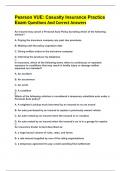Exam (elaborations)
Pearson VUE: Casualty Insurance Practice Exam Questions And Correct Answers
- Course
- Institution
Pearson VUE: Casualty Insurance Practice Exam Questions And Correct Answers An insured may cancel a Personal Auto Policy by taking which of the following actions? A. Paying the insurance company any past due premiums B. Waiting until the policy expiration date C. Giving written notice t...
[Show more]



